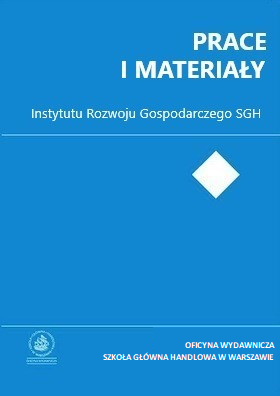Koszty w cyklu koniunktury
##plugins.themes.bootstrap3.article.main##
Abstrakt
Artykuł omawia wybrane relacje przychodów i kosztów w cyklu koniunktury. Koszty zwykle postrzegane są jako wskaźniki opóźnione, tj. rosną po przekroczeniu górnego punktu zwrotnego cyklu koniunktury i spadają przez czas jakiś po osiągnięciu przez gospodarkę dna. Jednak relacja przychodów do kosztów z wyprzedzeniem pokazuje załamanie aktywności gospodarczej. W artykule omówiono wyprzedzający charakter relacji przychodów przedsiębiorstw do kosztów prowadzonej działalności gospodarczej, w szczególności: relację cen producentów do jednostkowych kosztów pracy, relację przychodów ze sprzedaży do zapasów wyrobów gotowych oraz relację długookresowych do krótkookresowych stóp procentowych. Relacje te przedstawiono dla gospodarki polskiej lat 1999-2011. Statystyki narodowe dostarczają bogatego materiału nt. szeroko rozumianych przychodów i kosztów. Odpowiednio skonstruowane na podstawie tych danych wskaźniki mogą być przydatne w prognozowaniu nadchodzącego załamania gospodarczego. (abstrakt oryginalny)
##plugins.themes.bootstrap3.article.details##
Bibliografia
Ahrens R., Predicting recession with interest rates spreads: A multicountry regime-switching analysis, Journal of International Money and Finance”, vol. 21, nr 4, 2002, s. 519-537
Bange M., Capital market forecasts of economic growth: New tests for Japan, Germany and United States, „Quarterly Journal of Business Economics”, vol. 35 , nr 4, 1996
Bernanke B., On the predictive power of interest rates and interest rates spreads, „New England Economic Review” (Federal Reserve Bank of Boston), listopad/grudzień 1990
Bernanke B., Blinder A. S., The federal funds rates and the channels of monetary transmission, „American Economic Review”, vol. 82, nr 4, 1992, s. 901-921
Blinder A. S., Maccini L. J., Taking stock: A critical assessment of recent research on inventories, „Journal of Economic Perspectives”, vol. 5, nr 1, 1991, s. 73-96
Boschan Ch., Zarnowitz V., Cyclical indicators: An evaluation and new leading index, NBER, 1975 Brauer D. A., Do rising labor costs trigger higher inflation?, „Current Issues in Economics and Finance” (Federal Reserve Bank of New York), vol. 3, nr 11, 1997 Drozdowicz-Bieć M., Cykle i wskaźniki koniunktury, Poltext, Warszawa 2012
Dun & Bradstreet, „Monthly Review”, roczniki z lat 1933-1986 Evans M., A macroeconomic model of the term structure of interest rates, New York University Salomon Brothers Center, Working Paper nr 445, 29, 1989
Harvey C., Interest rate-based forecasts of German Economic Growth, „Weltwirtshaftliches Archive”, vol. 127, nr 4, 1991
Harvey C., The relation the between term structure of interest rates and Canadian economic growth, „Canadian Journal of Economics”, vol. 30, nr 1, 1997
Harvey C., The term structure and world economic growth, „Journal of Fixed Income”, nr 1, 1991
Haubrich J., Dombrosky A., Predicting real growth using the yield curve, „Economic Review” (Federal Reserve Bank of Cleveland), vol. 32, nr 1, 1996, s. 26-34
Hu Z., The yield curve and real activity, IMF Staff Paper, vol. 40, nr 4, 1993
Hultgren T., Changes in labor costs during cycles in production and business, w: Changes in labor costs during cycles in production and business, NBER, Cambridge 1960 International comparison of productivity and unit labor costs trends news release, „Economic News Release”, Bureau of Labor Statistics, USDL, 2008
Kask Ch., Neef A., Sparks Ch., International comparison of manufacturing unit labor costs, „Monthly Labor Review”, USDL, 1993
Keen H., The yield curve as a predictor of business cycle turning points, „Business Economics”, vol. 24, nr 4, 1989
Kuh E., Profits, profit markups and productivity, Study Paper nr 15, G. S. Joint Economic Committee, Study of Employment Growth, and Price Levels, 1960
Laurent R., An interest-based indicator of money policy, „Economic Perspectives” (Federal Reserve Bank of Chicago), vol. 12, nr 1, 1988
Laurent R., Testing the spread, „Economic Perspectives” (Federal Reserve Bank of Chicago), vol. 13, nr 4, 1989
Lerner L. J., Zarnowitz V., Cyclical changes in business failures and corporate profits, w: Business cycle indicators, vol. 1, pr. zb. pod red. G. H. Moore’a, UMI, NBER, Cambridge 1961
Moore G. H., Business cycles, inflation and forecasting, UMI, NBER, 1983
Phillips K., The composite index of leading economic indicators: A comparison of approaches, „Journal of Economic and Social Measurement”, vol. 25, nr 3-4, 1998-1999, s. 141-162
Skrzypczyński P., Metody spektralne w analizie cyklu koniunkturalnego gospodarki polskiej, „Materiały i Studia NBP”, Zeszyt nr 252, NBP, Warszawa 2010
Stock J., Watson M., Forecasting output and inflation: The role of asset prices, materiał niepublikowany, Kennedy School of Government, Harvard University, 2000/2003
Stock J., Watson M., New index of coincident and leading indicators, „NBER Macroeconomic Annual”, nr 4, MIT Press, Cambridge 1989
Zarnowitz V., Cost and price movements in business cycles theories and experience: Hypothesis of sticky wages and prices, Working Paper nr 3131, NBER, Cambridge, 1989
Zarnowitz V., Business cycles. Theory, history, indicators, and forecasting, The University of Chicago Press, Chicago 1992
